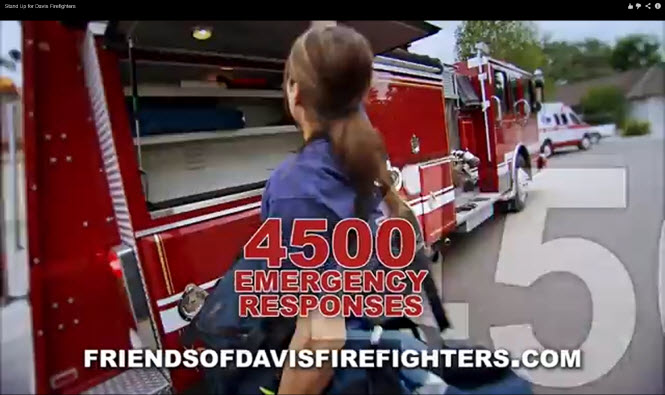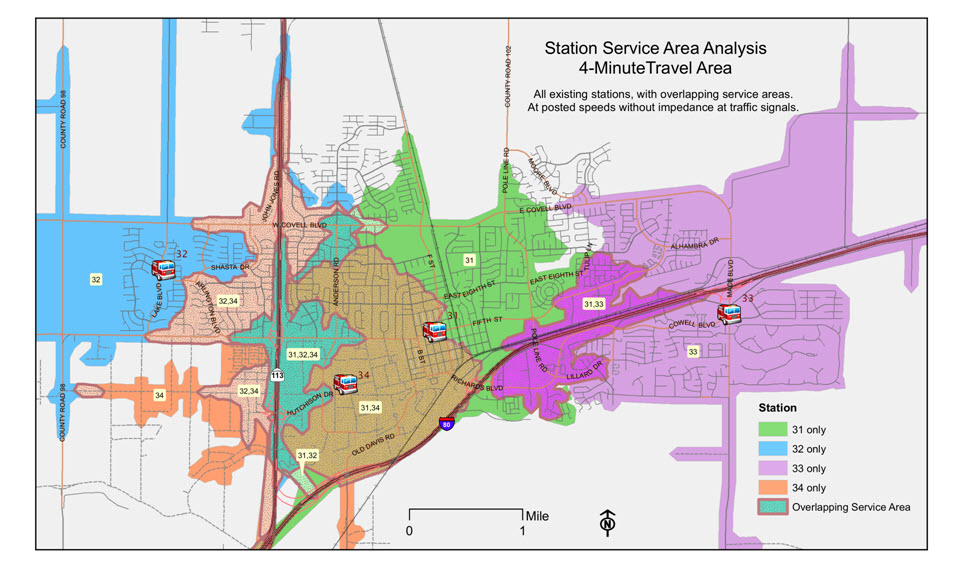
Council was impressed about the impact of the potential Cannery Park development on fire coverage. An individual writing as Karen G asked, “Where is the fire department for this side of town?”
The individual continued, “Can someone please address how an already thinly stretched fire department is supposed to handle MORE? How are the people needing services supposed to WAIT even longer in a life threatening emergency? How is this town supposed to grow when it is having a hard time providing for itself (police, fire, schools) now?”
The answer, of course, is already under consideration. As we reported back in July, the city of Davis is in the process of examining ways to move the central fire station from its current location on Fifth and E northward toward Covell Blvd.
The process started back in April when the Davis City Council voted by a 3-2 margin to reduce overall staffing to 11 firefighters, while looking at either moving or adding a fire station in northern Davis to better align the city’s resources.
While the council was split on the staffing changes, they were unanimous on the issue of the fire station relocation. In April, the Vanguard found that a close examination of this new information reveals that the city could resolve most of the concerns of residents about the staffing changes by a common sense redeployment, moving Station 31 north from 5th Street to North Davis.
As we noted at the time, boundary drop gives the city considerable flexibility and the ability to move the central fire station northward. With the boundary drop, the boundary in coverage areas shows overlap between Station 34 (UC Davis’ fire station) and Station 31, which is the central fire station. The map shows that Station 34’s four-minute zone ends at Station 31.
The Vanguard wrote, “That means, in a world where we have boundary drop, Station 31 is misplaced. Station 34 can comfortably respond to a huge area currently covered by Station 31. By moving Station 31 up to Covell, the station can still cover its current zone, but could then also reasonably cover Wildhorse and the northern areas to the west, easily within the four-minute travel time.”
Moving the fire station to Covell would allow the northern areas to the east and west of Pole Line to remain under the four-minute response time and still allow both UC Davis and the newly-located Station 31 to keep the core of town covered within a four-minute travel time.
In early July, the council voted to add $2.3 million to the Fire Station Relocation Project, which will be funded by public safety impact fees.
“We will start doing initial cost estimations and we will come back to you with a report with the first round of site review and a better idea of what we think the actual costs will be,” City Manager Steve Pinkerton told the council
The city manager sees this as about a 30-month process, with a year going for planning and then another 18 months for site work and construction.
In the debate on the Davis Enterprise site, Rich Rifkin jumped in after an individual asked, “Why not keep the central station where it is, and just build a smaller station in a northern location?”
The problem there is the cost and there really is no such thing as a small station.
As Mr. Rifkin explained: “UCDFD (Engine 34) is presently covering the downtown when it is the nearest company available. This was made possible–over the objections of the fire union–by the boundary drop, adopted this year. Previously, if Engine 31 (downtown) was on a call in, say, North Davis, and a home on A Street caught fire, Engine 34 was not allowed to be the first responder. The UCD fire station is about 2 minutes away, while South Davis (Engine 33) is about 10 minutes.”
He continues, “If, as part of the Cannery project, a new station is built and the downtown station is relocated there, residents of Davis will have in normal circumstances faster response times for fires and medical emergencies. (The exception would be if there are two simultaneous emergencies in the downtown. Then the second call might get a slower response, not having the current overlap.)”
He also addresses the cost of opening an additional fire station, “There is one serious reason why we can’t keep the downtown station open and build a new station at the Cannery: money. It would likely cost an additional $1.6 million per year that we do not have to staff it (including all costs of compensation). And since we have so few structural fires in Davis, there is no reason to add another station. The four we have (with UCD) plus the AMR service plus the newly de-coupled Rescue truck (with 2 ff’s aboard) means fairly quick response times for calls, now (though not so good in far West and far South Davis when their companies are repositioned out of area). And the average response times will get even faster if the downtown station is moved to the Cannery.”
Mr. Rifkin’s fairly accurate response was met with hostility from an individual we suspect to be a firefighter, posting as “Ryan.” Ryan responded, “Wow Rich, once again you are wrong! If 31 (or any engine) was on a call and a structure fire broke out anywhere in the city that empty spot would be filled by E34. So no, the fire union did not put up a fight to block the mutual aid agreements that the City has had with the University.”
He takes a shot at me too, “I’m glad ‘David’ can handle the fire issue since he is an expert as well.”
He continues, “E34 CAN”T cover ‘majority’ of the core. Based off the coverage maps they can cover a sliver of it along B St. That’s if there are no students walking and riding bikes through campus and the numerous gates E34 must go through are open. If you relocate E31/R31 to North Davis you now create a new coverage problem South of the core and delayed response to majority of it. But other than that sounds like a great idea to move E31/R31 out of the core where majority of the calls and majority of the money is.”
If you look carefully at the map posted above, you see that the four-minute travel time for Engine 34 actually extends well past B Street all the way out to F Street and the Amtrak Station. You can also see that much of that core would still be well within the four-minute response time if the station were moved to Covell.
The difference is that areas of Davis that are outside of the current four-minute responses north of Covell between 113 and the railroad tracks, as well as Wildhorse and areas south of Covell, would now be in the four-minute travel zone.
Ryan is correct that some of the southernmost areas might escape the four-minute travel time, but that’s a far smaller area than what is missing now. But there would be three stations that would be able to assist fairly quickly there, as well.
Mr. Rifkin then responded, “Ryan, that is the policy now, since the boundary drop, which you opposed. What the boundary meant, Ryan, was that if a fire or medical call came inside the City limits, E34 could not be the FIRST to respond. It could only help out as a second responder in mutual aid. It still can serve in mutual aid if a Davis company is there first. But if that house on A Street were burning down while E33 was stuck behind traffic at Richards Blvd and we still had the union’s boundary in place, E34 would have to wait while the house burned.”
He continued, “No one ever said the boundary prevented mutual aid. It harmed public safety, because it prevented the university company from being a first responder to fire or medical calls inside the City limits. Due to your union buying influence on the City Council, public safety was harmed for 20 years with that boundary.”
“It was the result of corruption,” Mr. Rifkin writes. “Fortunately, a majority of today’s Council cares more about public safety than about getting corrupt union firefighter money for their campaigns.”
Ryan then responds, “Rich, once again you are wrong! Currently under the new boundary drop policy if there is a fire in Davis or on the University every single engine, rescue, and truck (E31, E32, E33, E34, T34, R31) in the city and University responds leaving nothing to cover subsequent calls. The next available resource is Woodland or West Sac.”
He continues: “Pre-boundary drop E34 was left available (covered subsequent calls) unless another engine was on a call at the time of the first alarm. In that case E34 was added to the response. You don’t know the facts and you continue to miss-inform the public to support your agenda and personal vendetta against the Union. I think the end of your last post makes that clear. And like I told you before the Union supported the boundary drop.”
But that claim is directly contradicted by a number of officials, including Vice Chancellor of UC Davis John Meyer, who recently told me there is still considerable opposition from the Davis fire union on boundary drop.
The firefighters unfortunately have not recognized that they have lost this fight and should be working with the city and UC Davis to create the most cost-effective joint management and cooperation that they can.
—David M. Greenwald reporting


[quote]and the numerous gates E34 must go through are open[/quote]
I got a chuckle out of this one. I’ve witnessed at close hand — about 5 feet — how E34 handles a closed campus gate: the firefighter in the passenger seat of the cab hops out, grasps the wooden gate arm with both hands, pulls it back until it snaps, casually discards the broken gate arm and gets back in the truck. Total delay: about 10 seconds. It’s pretty entertaining.
this is pretty hilarious. it’s for the firefighters to work with the city rather than fighting every step of the way. that way, they may get somethings they think they need.
Amending what I wrote above, I think E34 is equipped with a gate actuator or gate code, but what I witnessed was an instance in which that didn’t work for some reason. The firefighter didn’t hesistate to break the gate and was very nonchalant about it, so I inferred that it’s not an uncommon occurrence.
The gates can be activated by a card key, but using one still requires getting out of a high cab. Dispatch can also open the gates remotely, but that doesn’t always work. Opening the gate by the “manual” technique is usually followed by a request from the engine for dispatch to tell facilities about the broken gate, so they can get it repaired.